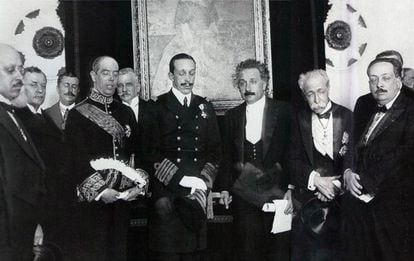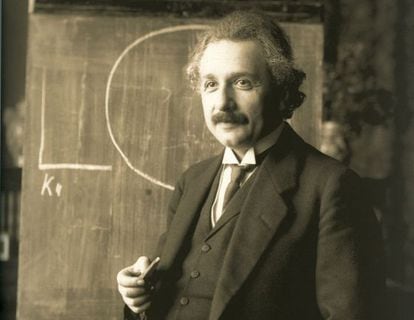Einstein’s two surreal weeks in Spain
Physicist received a hero’s welcome in 1923, although few at the time understood why

When Albert Einstein visited Madrid in 1923, a chestnut seller recognized him on the street and yelled out: “Long live the inventor of the automobile!”
The surreal anecdote is recounted by US historian Thomas F. Glick, and perfectly captures the essence of the German physicist’s trip to Spain between February and March 1923.
During his visit, Einstein delivered lectures in Barcelona, Zaragoza and Madrid, and for two weeks was the star of Spanish social life.
Francoists wanted nothing to do with Einstein, because he was a pacifist and a separatist red”
Historian Thomas F. Glick
Everyone knew who he was, although just a handful of people actually understood what he had discovered.
The media in particular struggled to describe his work, and often resorted to physical descriptions of the man instead. “The endearing carelessness of his looks and his handsome head of tousled gray hair made him look more like a Latin artist than a German thinker,” noted El Heraldo de Aragón.
“His mouth is sensual, very red and rather large; there is a permanent smile on his lips, either kindly or ironic. Who could define him? He is tall (maybe 1.75 meters),” said the national daily ABC on March 2.
Einstein arrived in Barcelona on February 21, 1923 on a train from France. The previous year, he had received a Nobel Prize for his discovery of the law of the photoelectric effect. And in 1919, a British expedition to Africa had proven that his revolutionary theory of relativity was correct.
So he was a global celebrity by the time he arrived in the Catalan capital. But there was nobody out at the station to greet him, because he had forgotten to tell his hosts which train he was traveling on. So he and his wife simply walked over to a nearby bed and breakfast, as Glick explains in his book The Spaniards and Einstein: Science and Society in Interwar Spain.
The German-born scientist had been invited to speak in Spain by Esteve Terradas, another physicist, and by Julio Rey Pastor, a mathematician. Terradas had offered him 7,000 pesetas for lectures in Barcelona and Madrid, which was as much as a university professor made in two years in those days.
But Einstein “was not concerned about the payment for his lectures and books,” according to the physicist Hanoch Gutfreund, former president of The Hebrew University of Jerusalem and one of the world’s greatest experts on the father of the theory of relativity.

“He went to Spain because he had promised to do so when he received the first invitation from Rey Pastor in 1921. He left Germany after the assassination of Foreign Minister Walther Rathenau by far-right activists. Einstein was also a target, so it was advisable for him to disappear for a while,” holds Gutfreund.
And so the physicist – who, like the assassinated minister, was Jewish – embarked on a long trip that took him to Japan, Palestine and Spain.
Spaniards gave Einstein a hero’s welcome, although like the chestnut vendor, they were unsure why.
The writer Julio Camba admitted as much in the newspaper El Sol on March 6, 1923: “When he showed up before the audience that packed the hall inside the School of Science, Mr Einstein was greeted with a round of applause. Undoubtedly, everyone gathered there admired him greatly, but if anyone had asked us why we admired him, we would have been very hard pressed for an answer.”
There was nobody at the station to greet him, as he forgot to tell his hosts what train he was traveling on
The journalist Joan Colominas was even more self-deprecatory in a story that ran in El Pueblo on March 2, as Glick notes: “We must confess that many of those present extracted from the lecturer’s explanations what the black man extracts from a religious sermon, as demonstrated by the weary looks on many well-known faces, and the sighs of relief that rose from our collective chest when the final words were uttered,” wrote Colominas, using a racist metaphor that was common at the time.
Einstein was attempting to explain his theory of general relativity. The philosopher Joaquim Xirau Palau was there at Einstein’s lectures, and wrote that “of the hundred or so people in attendance, there must have been four or five who followed it perfectly, and perhaps a dozen more who guessed something with great effort.” The rest were completely clueless, he said.
But despite Spanish society’s interest in Einstein’s visit, little came of it.
“I don’t think that Einstein’s visit served to Europeanize Spanish science,” notes Glick. “His trip left no mark. And the Civil War ended up erasing his visit. Francoists wanted nothing to do with Einstein, because he was a pacifist and a separatist red.”
The historian Ana Romero de Pablos, who co-authored the book Einstein en España (Einstein in Spain), agrees with this view. “Einstein’s visit left no research lines open in Spain, just a feeling of admiration,” she sums up.

Romero de Pablos, a researcher at the Spanish National Research Council’s Institute of Philosophy, has studied the way the Spanish press covered Einstein’s visit in 1923. “Nobody or nearly nobody understood Einstein; but the newspaper cartoons turned him into an important character who was part of everyday life,” she says. “And that connection with popular reality was the best way to communicate, celebrate and build hero worship.”
The cartoonist Luis Bagaría devoted many cartoons to Einstein in El Sol. In one of them, a boy asks his father:
–Tell me, dad, is there anyone wiser than Einstein?
–Yes, son.
–Who?
–The person who understands him.
Einstein’s world was so abstract that the national press simply focused on every move made by the physicist, rather than on what he said
Another cartoon has the following caption: “Einstein says there are no straight lines, just curves.” In the drawing, a man yells at a passing woman: “Oh, what curves! Long live Einstein!”
The German physicist left Spain on March 11, 1923, but not before receiving a surprising proposal from marine biologist Odón de Buen. At Einstein’s last lecture in Madrid’s Ateneo, the biologist proposed that Einstein should lead a Spanish-Mexican expedition to study the next solar eclipse in Mexico, in September of that year.
“Einstein would head the research group for a year, bringing scientific prestige to Spain,” explains Glick.
On June 8, Einstein sent in his reply, politely declining the offer.
English version by Susana Urra.











































